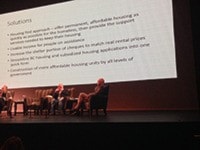When you’re not well mentally, the threat of losing your place to live and ending up on the streets just adds to the burden.
It’s especially tough if you’re not working, and are on B.C. income assistance and you’re single and struggling to get by on the $610 monthly cheque. The portion of that allocated to shelter is $375 a month, leaving a monthly amount $275 for food and clothing.
“The amount you get for shelter portion is incredibly, incredibly low,” said James Millar, Wednesday at Maple Ridge’s final Community Dialogue on Homelessness.
“How are you supposed to live on that little amount of money? These people have mental health issues. They’re going through really hard times. On top of that, their income is so low, they can’t really afford to have housing. It’s really sad, actually.”
Millar’s had his own struggles and said that when housing is uncertain, “It weighs on you so much. It’s hard to move forward in recovery to get to a better place,” and to be able to contribute to society.
He was one of four panellists at the final session Wednesday at the Arts Centre Threatre as Maple Ridge considers a proposal to build a $15-million shelter and supportive housing complex at 21375 Lougheed Hwy.
Millar is with Canadian Mental Health Association’s peer navigator program in Vancouver and said homeless people are stuck on waiting lists for years to access subsidized housing, saying only 12 per cent of the program’s clients were placed in housing last year.
BC Housing wait lists are between three and seven years, he added. But it might take only a year to get into a single room housing, he added. He called for a streamlined application for housing programs.
“From my experience, you can only stay in a shelter for a limited amount of time.”
He said in response to a question that the government not only needs to increase the amount of housing available, it also has to raise the income assistance rates so people can actually afford a place to live.
“I think the shelter portion of the cheques need to match the real rental prices in the community so that people can get the housing they need,” Millar said.
Monthly rents are more than $930 for bachelor suites in Vancouver.
Dominic Flanagan, with BC Housing, said that B.C. is one of the first provinces in Canada to follow the Housing First approach in which street people are provided stable housing first, then supported with a range of services to help them towards self reliance.
Emergency shelters which connect people with services, are considered a best practice and are a type of Housing First.
“Our … shelters play a key role … in bringing people in off the street.”
Flanagan said the government is spending $75 million a year for 1,850 shelter spaces around B.C. Those shelters allow people to stay inside indoors all day so that staff can connect residents with help, something that’s not found in the rest of Canada. Most, about two-thirds of B.C. towns, have only one shelter, he pointed out.
“The shelters act as a gateway to assist people to find more permanent housing and deal with personal life challenges,” that keep them from staying housed.
“We believe that the minimal barrier model is a way to ensure that the most vulnerable homeless people are brought indoors … and provided opportunities to move towards recovery programs or more permanent housing.”
Minimal barrier is when people are given space to store their belongings, given harm reduction supplies such as needles, and possibly bring in their pets.
Homeless people are some of the most marginalized and disenfranchised people in our communities, he added.
Strategies are also needed to address the causes that drive people into homelessness, he added. Flanagan showed via a slide presentation that showed that Maple Ridge has 25 shelter beds at the Salvation Army Ridge Meadows Ministries and another 40 shelter beds at the temporary homeless shelter operated by RainCity Housing, also on Lougheed Highway.
Meanwhile, Alouette Heights provides 46 supportive housing bachelor suites and provides another 40 rental supplements so that people can afford to stay in market housing.
Alouette Addictions Services also provides 60 rental subsidies, and the required services for the residents, while the Canadian Mental Health Association does the same with 40 rental supplements.
Sandy Burpee, with the Tri-City Homelessness and Housing Task Group, said the new 3030 Gordon shelter and supportive housing complex in Coquitlam which opened a year ago, does have ongoing issues, which are addressed by a liaison committee. But lately the complex has stabilized and “a sense of home has developed.”
He said there’s a lot of misinformation around Maple Ridge about 3030 Gordon. But he’s been impressed with how its operators, RainCity Housing is running the place and addressing issues.
Therapist Mike Pond who’s also had his own addiction issues chronicled in his book he wrote titled Wasted, said evidenced-based approaches have to be followed in dealing with homelessness.
He cited a major study showed that homeless youth were almost twice as likely to inject drugs as kids who had homes.
Pond said another study showed that those who’d been sexually abused as kids were more than 2.5 times likely to start injecting drugs.
But many housing options require people to be clean before allowing them in. “We just can’t make it. “We end up getting kicked out and being homeless again.”
Instead, safe and supportive housing is needed with harm-reduction measures.
But Flanagan said earlier that BC Housing doesn’t fund any abstinence-based shelters.
Flanagan said there’s no formula for determining how many shelter beds go in each community. He said in response to a question about the general lack of affordable housing that the federal government needs to step up and also get involved.
